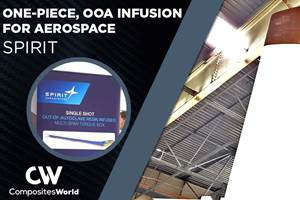Where is the automotive composites supply chain?
Long-time composites industry observer Dale Brosius, now a consultant and the president of Dayton, Ohio-based Quickstep Composites, the U.S. subsidiary of Australia-based Quickstep Technologies (Bankstown Airport, New South Wales), asks some hard questions about the composites industry's readiness to supply the auto industry with the materials and processes necessary to meet coming lightweighting challenges.
Having spent more than half my life in the composites industry, I have been fortunate to have been exposed to many materials, processes and end-use markets around the world. While I continue to be a strong proponent of composites, I also have developed a healthy dose of skepticism when it comes to predicting the growth rate of the industry. Although I remain optimistic, my aim here is to be provocative in describing the challenges that must be overcome.
Back in 1984, I came to Detroit with Dow Chemical Co. (Midland, Mich.) and was tasked with selling epoxy and vinyl ester resins to the auto industry. At my first meeting with Chrysler in Highland Park, an engineering manager told me that “by the end of 1985, Lee Iacocca” — remember him? — “will drive an all-composite vehicle off the assembly line.” I immediately envisioned a modern-day River Rouge plant, with trainloads of resin and fiberglass, instead of iron ore, coming in one end, and shiny, lightweight composite cars rolling out the other. The fallacy here was that the automotive OEMs thought the composites industry knew all about designing and manufacturing car parts in high volumes, and frankly, we assumed the same about the OEMs. The truth was, nobody did. A supply chain did not exist.
Chrysler left Highland Park many years ago, and Lee Iacocca left Chrysler, but the lack of a viable supply chain for large-volume composite vehicles is a problem that is still with us.
In 1987 a senior engineer at Ford told me they would not make the investment required to produce 30,000 to 50,000 composite vehicles annually, and clearly none of the existing molders of sheet molding compound (SMC) had the wherewithal to do so either, especially because the likely technology for the body-in-white would be resin transfer molding (RTM), which was still relatively nascent. And we were still talking about glass fiber — industrial-grade carbon fibers were some years away.
There is no shortage of challenges to making composite vehicles commonplace. However, today we have materials that can deliver lightweight structures, processing times are dropping rapidly and predictive analytical software is reducing development costs. The biggest impediment to widespread adoption is the enormous investment required in people and capital equipment. None of the existing molders of automotive plastics have pockets deep enough to underwrite such a cost. Becoming a supplier to the automotive industry isn’t easy; carbon fiber molders from other industries found this out a decade ago with small-volume vehicle programs. It is one thing to keep up with production rates of 10 to 20 aircraft per month, but it’s another thing entirely when volumes jump tenfold. Today the automotive market is looking for the capacity to support 1,000 to 3,000 composites-intensive vehicles per month, if not more. It is up to the OEMs to lead the way.
BMW has taken on this challenge and created a full chain for carbon fiber supply, weaving and, finally, molding the structures and assembling the vehicles. Outside companies manufacture the raw materials, but the biggest investments in molding equipment and assembly processes have been made by BMW, rather than its suppliers. The whole industry will be watching to see how BMW’s i3 and i8 succeed in the market, but even if the estimates of 30,000 carbon fiber vehicles per year is attained, this still represents less than 3 percent of BMW’s annual vehicle production. As big a deal as this is, it is still a long way from significant market penetration.
The key will be to see who, if anyone, follows BMW’s lead. If other OEMs, especially in Japan and North America, step up and do the same, then the rosy forecasts for automotive composites might, indeed, be correct. If not, then composites are clearly destined to remain a niche solution for improving emissions and fuel economy.
Quickstep Composites LLC
Related Content
Composite resins price change report
CW’s running summary of resin price change announcements from major material suppliers that serve the composites manufacturing industry.
Read MoreGKN Aerospace, Joby Aviation sign aerostructures agreement
GKN Aerospace will manufacture thermoplastic composite flight control surfaces for Joby’s all-electric, four-passenger, composites-intensive ride-sharing aircraft.
Read MorePlant tour: Albany Engineered Composites, Rochester, N.H., U.S.
Efficient, high-quality, well-controlled composites manufacturing at volume is the mantra for this 3D weaving specialist.
Read MoreVIDEO: One-Piece, OOA Infusion for Aerospace Composites
Tier-1 aerostructures manufacturer Spirit AeroSystems developed an out-of-autoclave (OOA), one-shot resin infusion process to reduce weight, labor and fasteners for a multi-spar aircraft torque box.
Read MoreRead Next
VIDEO: High-volume processing for fiberglass components
Cannon Ergos, a company specializing in high-ton presses and equipment for composites fabrication and plastics processing, displayed automotive and industrial components at CAMX 2024.
Read MoreAll-recycled, needle-punched nonwoven CFRP slashes carbon footprint of Formula 2 seat
Dallara and Tenowo collaborate to produce a race-ready Formula 2 seat using recycled carbon fiber, reducing CO2 emissions by 97.5% compared to virgin materials.
Read MoreDeveloping bonded composite repair for ships, offshore units
Bureau Veritas and industry partners issue guidelines and pave the way for certification via StrengthBond Offshore project.
Read More





















